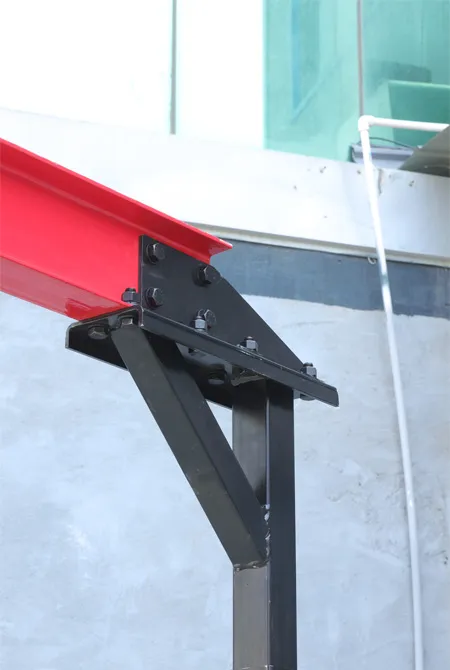gantry crane girder
Understanding Gantry Crane Girders Design, Functionality, and Applications
Gantry cranes are essential equipment in various industries, primarily used for heavy lifting and moving operations. One critical component of a gantry crane is its girder, which serves as the primary support structure for the crane's framework. In this article, we will delve into the details of gantry crane girders, exploring their design, functionality, and applications across different sectors.
What is a Gantry Crane?
A gantry crane is a type of crane that consists of a hoist being mounted on a framework that has two or more legs, which move on wheels or along a track. This crane type is particularly popular in settings where overhead cranes are impractical. The gantry crane offers versatility in material handling and is commonly found in shipping yards, manufacturing facilities, and construction sites. Its design allows it to span a wide area while providing stability, making it ideal for lifting heavy loads, often in outdoor environments.
The Importance of Girders
The girder is a crucial component of a gantry crane's structure, acting as the main horizontal beam that supports the weight of the loads being lifted. Girders are typically constructed from high-strength steel or aluminum, chosen for their ability to withstand significant stresses and loads. The design of the girder is paramount to the overall safety and performance of the crane. It must be engineered to support the dead weight of the crane itself, as well as the dynamic loads introduced during operation.
Design Considerations
When designing gantry crane girders, several factors must be taken into account
1. Load Capacity The girder must be capable of supporting the maximum load specified in the crane's operating conditions. This often involves detailed calculations to ensure that the material's strength can safely carry the expected loads, including dynamic loads caused by movement.
2. Span Length The distance between the legs of the gantry crane is known as the span. A longer span typically requires a more robust girder design due to increased bending moments and shear forces. Engineers must balance span length with material efficiency and weight.
3. Material Selection The choice of materials plays a vital role in the performance of the girder. Steel is favored for its high yield strength and ductility, while aluminum offers benefits such as lighter weight and resistance to corrosion. The specific application and environment will dictate the optimal material.
gantry crane girder

4. Deflection Allowable deflection limits must be established to ensure safe operation. Excessive deflection can lead to operational issues, such as difficulty in positioning loads accurately. Engineers will consider factors such as load types and movements when designing for optimal deflection.
5. Welds and Connections The points where the girder connects to other components of the crane, including the hoist and legs, must be meticulously designed to ensure structural integrity and load transfer.
Applications
Gantry crane girders are employed in numerous applications across various industries
1. Shipping and Port Operations In port facilities, gantry cranes are vital for loading and unloading containers. Their wide spans allow them to easily handle large shipping containers, enhancing port efficiency.
2. Manufacturing In manufacturing plants, gantry cranes facilitate the movement of heavy machinery and components. Their adaptability allows for efficient workflows, minimizing transportation time within the facility.
3. Construction Construction sites frequently utilize gantry cranes for lifting heavy materials such as steel beams, concrete panels, and large equipment. The ability of the crane to maneuver around a job site makes it invaluable for complex builds.
4. Maintenance and Repair In large maintenance facilities, girder cranes provide the necessary lift for conducting repairs on heavy equipment and vehicles, allowing technicians to work safely and effectively.
Conclusion
Gantry crane girders are an integral part of the lifting mechanics in various industries. Their design impacts not only the efficiency of material handling operations but also ensures safety and reliability in heavy lifting tasks. As technology advances and industries evolve, the continued innovation in gantry crane girder design is likely to enhance their functionality and applications further, solidifying their role in modern industrial practices. Understanding their importance can help in making informed decisions regarding crane selection, operation, and maintenance, ultimately leading to greater productivity and safety in the workplace.
-
Unlock Seamless Relocation with Our Heavy Equipment Moving ExpertiseNewsJun.06,2025
-
Unleash Unrivaled Flexibility with Our Adjustable Gantry CraneNewsJun.06,2025
-
Unleash Heavy-Duty Efficiency with Our Industrial Gantry Crane SolutionsNewsJun.06,2025
-
Revolutionize Steel Handling with Our Magnetic Lifter RangeNewsJun.06,2025
-
Master Equipment Mobility with Premium Machinery Mover SolutionsNewsJun.06,2025
-
Elevate Your Material Handling with Magnetic Lifter TechnologyNewsJun.06,2025
-
YS Permanent Lifting Magnets: The Smarter Way to Handle SteelNewsMay.22,2025
